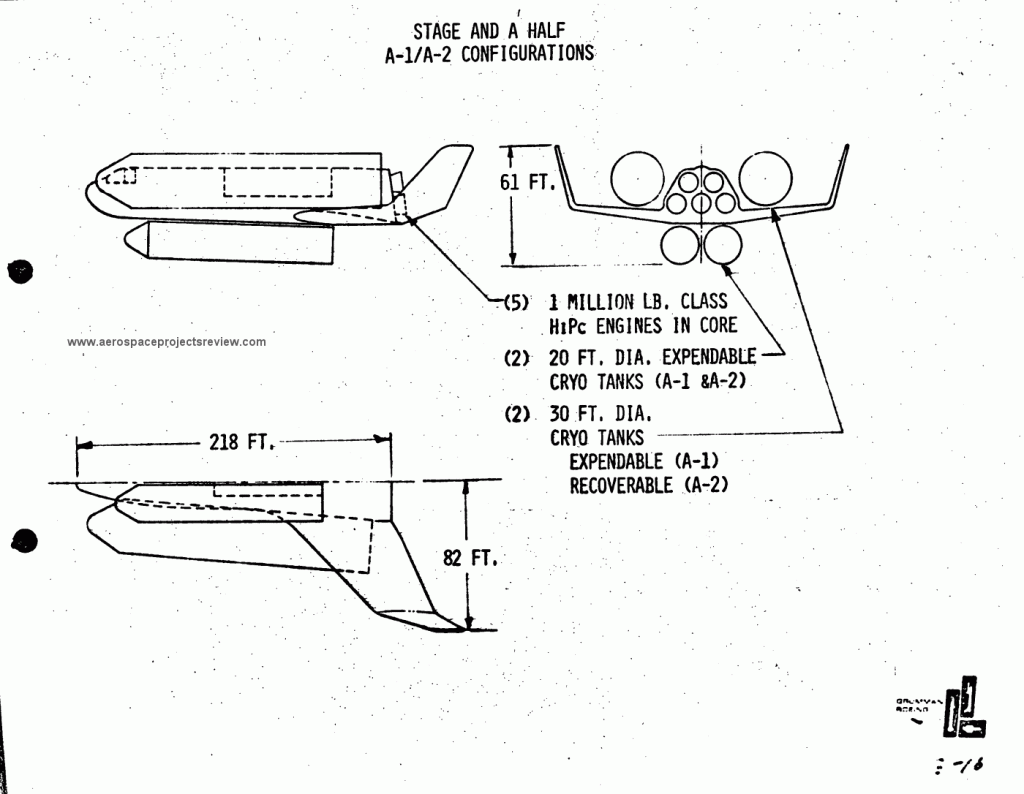One of the more unconventional Space Shuttle concepts was this minor Grumman concept from 1971. Similar to the Lockheed STAR Clipper stage-and-one-half design, this design featured a fully reusable rocket powered spaceplane with expendable propellant tanks. Unlike the STAR Clipper, the Grumman design had four unattached tanks and a non-lifting body wing-body orbiter.
Search Results : Shuttle
The original Galileo 7 shuttlecraft is up for auction. Warning: it’s a bit of a handyman special.
Sitting here working on a project for a client, with CNN on as background noise. The shuttle Enterprise is being flown into New York City for some reason (because, sure, when you think “space program,” what comes to mind faster than “New York City?”), and CNN’s reporterbots are doing their thing. I had to cringe when John Zarrella started yamming about the Russian “Boron” (yeah, “Boron”) space shuttle… which, according to him, never flew into space, only “suborbital” flights just like the Enterprise.
D’oh.
An animation from NASA-Langley, 1972, showing structural/vibrational responses of an early Space Shuttle configuration. While hardly “Avatar,” it’s certainly interesting to see such early CGI.
[youtube D-b6ko4wbZ0]
Three years later, Case Western Reserve University produced another structural response video, this time of an SST configuration. In those three years, some pretty obvious advances were made.
[youtube LsN1V8d7-8c]
From 1970, a Grumman Alternate Space Shuttle design that utilizes the S-IC booster from the Saturn V. Quite a number of Space Shuttle concepts called for the S-IC to be used as a first stage booster, as an expendable stage, a partially reusable or fully reusable stage. Shown here, the basic S-IC would be expendable. However, a second option would be to use a modified S-IC where the outer four engines would drop off during ascent and would be recovered. This is the same concept that Boeing proposed for the S-ID stage (see the October 2008 issue of the AIAA-Houston “Horizons” newsletter for more on the S-ID).
The use of a S-IC – stock or modified for partial recovery – would have presented a number of advantages, not least being that the existing Saturn launch facilities could be used. The S-IC would have provided adequate launch performance; the use of recoverable engines would have lowered cost and increased performance. However, the S-IC production line had been shut down for some time, and restarting it would have proven not only politically dubious (restating the S-IC would have led to questions about restarting the rest of the Saturn/Apollo line), but also expensive.
Slightly more on this is HERE.
In October of 1969, General Dynamics/Convair reported to NASA on their Space Shuttle design work. This included a series of vehicles that utilized boosters and orbiters of similar geometry… basically little more than flat-bottomed aeroshells wrapped around the oxygen and hydrogen tanks. Both the booster and orbiter used turbofans stowed in the nose for flyback, and high aspect ratio variable geometry wings.
A number of configurations were studied, including triamese configurations with two boosters that had considerable commonality with the orbiter, to two-stage systems with entirely different boosters and orbiters. Payloads studied ranged from 25,000 pounds to 50,000 pounds. Note in the scale drawings below that the 50K version was virtually the same size as the Saturn V. This was due in part to the all-hydrogen fuel, and part as a consequence of reusability.
Higher rez versions of these drawings are posted HERE.
I offhanded mentioned last week the idea of getting funding for an expedition to an archive I know to have a goldmine of NERVA/SPS and especially early Shuttle documentation. If I could find at least ten people willing to promise to part with $100 each (to fund airline tickets, motel/car/food/cat boarding/etc.) in exchange for a complete set of DVD’s of all copies and scans (barring any ITAR stuff for non-USAians, of course), then I’d get to work on actually setting up such a trip.
I got a few responses to that via commenting and email… four people chimed in (G.A., J.R., M.C., J.N.). Anyone else interested? Ten’s the minimum (or at least, the financial equivalent of ten… if someone wants to kick in $10,000, that would be just fine).
UPDATE: I just checked… the archive remains, and remains accessible. Yay!
UPDATE 2: I have booked the trip! Last week of March. Yow… pricey. I kinda underestimated the cost of it all. Oh, well… Anyway, if you’re interested, now’s the time to get on board!
The basic layout of the final Space Transportation System, as envisioned by McD in ’71. There are a number of important differences… perhaps most importantly the inclusion of four high-pressure rocket engines on the orbiter rather than three. The SRMs were slightly larger in diameter at 156 inches.
Historical note: a number of rocket designs through the years have been 156 inches in diameter. This is not due to 156 inches being a magical performance enhancer, but due to trains. Specifically, 156 inches is the largest diameter for a cylindrical payload on a rail car that will fit through standard railway tunnels in the US.






